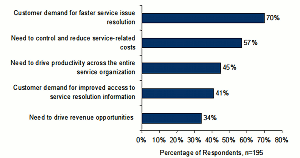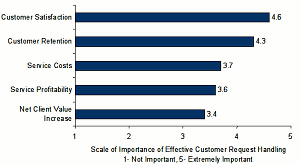
The use of analytics in contact centers enables management to extract critical business intelligence that would otherwise be lost.
By analyzing and categorizing recorded conversations between companies and their customers, useful information can be discovered relating to strategy, product, process, customer satisfaction/retention, and operational issues. This information gives decision-makers insight and the ability to react quickly to customer sentiment and behavior, as well as customer response to both outbound and nascent market and brand positioning.
Aberdeen Group’s contact center research provides fact-based insights that reveal the best practices leveraged by business and IT decision-makers to ensure the effective delivery of customer service and call center excellence to drive customer satisfaction and overall profitability. As commoditization pressures in a global economy drive down margins on the product-side of business, organizations are looking to leverage their service operations to differentiate themselves from their competitors through contact center excellence, which in turn leads to overall improved business performance.
Primary Pressures
In September 2009, Aberdeen Group surveyed over 190 service professionals to distinguish Best-in-Class companies from Industry Average and Laggard. Analysis of the respondent data revealed that the primary pressure driving forward the evolution of the respondents’ contact center initiatives was customer demand for faster service issue resolution — improved time to repair and first-call resolution (Figure 1).

For the servicing organization, the proliferation of service channels is both a blessing and a burden. With pressure on these organizations to meet customer demands for faster service coupled with rising service-related costs (Figure 1), the availability of multiple channels affords the servicing organization with numerous avenues to expand the reach of service information and updates while injecting efficiency in the delivery of service.
Customer requests can be segmented and directed to appropriate channels, thereby enabling faster access to information along with a lower burden on more expensive service-based resources. For example, with access to numerous service delivery and customer contact channels, connections that were initially made via the contact center, and could have resulted in an unnecessary dispatch, can now be rerouted to Web-based self-service channels that require very little use of limited contact center and field-based resources. With an established hierarchy of service delivery channels, it isn’t only the customers who can approach the servicing organization from numerous angles, but also the servicing organization that can enable customer service delivery via the most efficient channel.
Establishing Policies, Integrating Data
However, the existence of a multi-channel support network also increases the responsibility on the servicing organization to ensure the accuracy and validity of information that is disseminated through each and every one of these channels.
Regardless, service organizations surveyed for this research place extreme importance on the efficient handling and resolution of customer service requests via the contact center and other non-field-based channels. On a scale of 1 to 5, with 1 being “not important” and 5 being “extremely important,” respondents to Aberdeen’s September 2009 survey indicated a result of 4.6 with regards to the vitality of effective customer request handling on customer service, with a 4.3 score on the importance to customer retention (Figure 2).
Harnessing analytics in the contact center is not new, yet Aberdeen’s research shows that organizations have been slow to adopt the technology. The challenges lie in the ability to establish data management policies, integrate the resulting data streams into a knowledge discovery process, and organize the results into a meaningful and actionable plan that aligns with corporate goals.
In the absence of these abilities, real analysis of contact center interactions is compromised and visibility is reduced to spotty monitoring and anecdotal recounts.
Gaurav Patil is a research associate at Aberdeen Group.












































